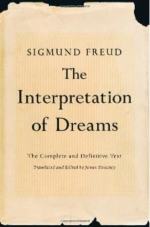
|
| Name: _________________________ | Period: ___________________ |
This test consists of 15 multiple choice questions and 5 short answer questions.
Multiple Choice Questions
1. Whose findings does Freud cite at the beginning of this chapter?
(a) Carter
(b) Stricker
(c) Hillebrandt
(d) Jung
2. Freud begins with the retelling of a dream that one of his patients had after hearing the story of the same dream at a ___________.
(a) retreat
(b) class
(c) meeting
(d) lecture
3. This displacement is also carried out as a _____________ of condensing.
(a) factor
(b) facilitator
(c) instigator
(d) necessity
4. A dreamer who recognizes he is dreaming has slipped past the _____ that transpose the dream thoughts.
(a) words
(b) actions
(c) censors
(d) images
5. Everything in dreams that seems to be _________ is not but is instead what Freud considers dream thoughts that find their way completely as latent dream content.
(a) intellectual
(b) simple
(c) useful
(d) logical
6. The displacement is carried out as having relevance to the ____________ associations.
(a) childhood
(b) dream's
(c) dreamer's
(d) society's
7. Dream interpretation must be allowed to prove ______ consistently over time.
(a) valid
(b) itself
(c) fortune telling
(d) wrong
8. _______ and body stimuli are the physical sources of dreams, according to Freud.
(a) Head
(b) Nerve
(c) Skin
(d) Lung
9. Dream interpretation must not be based on ________ or exaggerated assumptions.
(a) childish
(b) crazy
(c) simple
(d) false
10. Freud does admit that some dreams contain symbols the are responding to ____________ stimuli.
(a) psychic
(b) physical
(c) mental
(d) memory
11. When the dream has been _______, that's when the dream can be changed.
(a) found out
(b) over
(c) altered
(d) interpreted
12. Freud says that writers neglect to include or make less important the somatic dream stimuli if they involve any ________ activity.
(a) family
(b) psychic
(c) animal
(d) color
13. Which dreams appear alarming but are actually wish fulfillment dreams?
(a) Anxiety dreams
(b) Death dreams
(c) Fire dreams
(d) Tornado dreams
14. Dream interpretation must be _________ based.
(a) science
(b) logic
(c) book
(d) religious
15. How many characteristics are specific to the nature of the dream?
(a) 2
(b) 7
(c) 3
(d) 4
Short Answer Questions
1. The dreamer of the dream in #134 also noted that the answer was throwing __________ at her.
2. Which of these is NOT considered to be a source of dreams, according to laymen?
3. What can threaten to undermine the very foundation of our efforts at dream interpretation?
4. To follow up #146, the answer cannot be denied, even though the dreamer might, upon waking, deny the subject of the __________.
5. Manifest dream content presents itself as symbols, which Freud calls _______________,
|
This section contains 363 words (approx. 2 pages at 300 words per page) |

|




